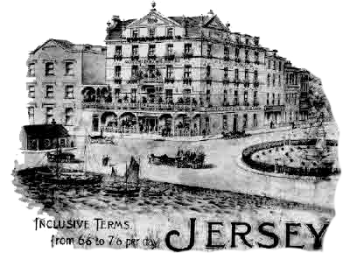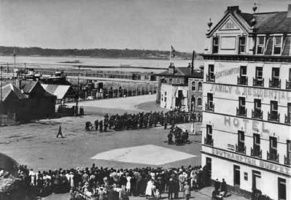
Wrong date
It has been widely acknowledged that the hotel was built in 1864, but this is inaccurate, and the wrong date has been perpetuated since it was given in Philip Ahier's The Historical Hotels and Inns of Jersey, published in the 1970s.
He wrote:
- "This is one of the few hotels which manifests to all and sundry the year in which it was built, viz, 1864; the date emerges from its pediment in upraised figures.
The date may well appear on the facade of the hotel, but Mr Ahier was not the first historian, nor will he be the last, to confuse a datestone on a building with the year of its construction. The hotel was almost certainly in existence three years earlier, because it is shown in the 1861 census, with Thomas Purkis as 'hotel keeper'. The address of the hotel is given in the census as 1 Esplanade/5 North Pier, which appears to be a correct description of the site on the corner of the Weighbridge and Esplanade. The adjoining Pomme d'Or Hotel is not named in the census but the previous entry is for 2-3 Esplanade and 11, 13, 15, 17 and 19 Conway Street, which coincides with the location of that hotel.
On the other side of the Southampton was the Custom House, at 4 North Pier, then another unnamed hotel as 2-3 North Pier, with the Navy Hotel making the corner with Wharf Street.
It may be that when Mr Purkis took over the hotel, not only was it renamed, but building work was carried out on the facade and the 1864 date was added. There was no change to the side of the hotel in this period from the view shown above, except for the change of name.
Hotel du Havre
It seems that the hotel's origins can be traced even further back, because a photograph has emerged of the building when it was called Hotel du Havre. We have so far been unable to find any record of this establishment, but the picture certainly predates other early images showing the hotel as the Southampton.
Mr Purkis, who married Mary Ann Jackman in St Helier in 1833, was shown as coming from Southampton, which strongly suggests that it was his idea to change the hotel's name. Whether Mr Purkis owned, leased or was simply the licensee of the hotel is uncertain. Thomas and Mary Ann were recorded in the 1841 census living in Bath Street with their daughter Charlotte. Thomas was shown as a pork butcher, and Charlotte's age was given as ten, although this was probably a result of the practice used for that census of rounding ages up or down to the nearest multiple of five. Whatever her true age, we have been unable to find any trace of Charlotte being baptised in Jersey, or of the couple having any further children.

Property transactions
The plot of land on which the hotel was built was sold by Jean Benest to Henry Gillman on 31 March 1823. The next transaction was a form of sale and lease-back by Mr Gillman on 26 March 1831, when the property was described as a maison and no reference was made to its use as a hotel or anything else. It appears that the first building on this site was completed after March 1823 and before March 1831. Mr Gillman then sold the maison in October 1833 to Sara Hardan and appears to have become insolvent in 1872, when his creditors repossessed his other property by way of décret.
The plot on which what became the Weighbridge Café was constructed is slightly more complicated. Jean Benest sold the land on 16 March 1825 to Nathaniel Westaway. He in turn sold it on, in two separate pieces; the east half, being bare land, to Charles Pinel and Elie Pinel, née de Ste Croix, his wife, on 4 February 1826, and the west half (with a house built on it) to Miss Moise de Ste Croix on 18 April 1829. She also acquired a house built on the east half from the Pinels on the same day, thereby reunifying the land (and the two houses now built on it) into single ownership. It may therefore be inferred that the buildings were commenced no earlier than March 1825 and February 1826, and completed no later than April 1829.
Finsbury Hotel site: Jean Benest sold this to Jean Sinel on 6 May 1823 and the plot extended as far as Wharf Street. Jean Sinel sold a magasin ou maison to Philippe Sinel on 8 April 1826. This once again gives a time frame of between May 1823 and April 1826 for construction to have been commenced and completed.
Later contracts tend not to ascribe names to the properties until the early part of the 20th century, just calling them magasins ou maisons . The building timeframe is obviously borne out by the 1834 Le Gros map clearly showing substantial constructions on the sites by then. At one time the Finsbury and Southampton were both owned by Fred Middleton, who transferred them along with a number of other pubs in the Island to Ann Street Brewery in July 1923.
The contracts all referred to the neighbouring land as being in Public ownership as quais or 'roads leading to the North quai or slip' or the new jettée of the havre de St Helier. The sales by Benest do not give an earlier provenance than 1823 other than he was 'fils Jean, fils Jean, fils Philippe'. It must have been inherited in the direct line but who was responsible for the reclamation and any transfer of the reclaimed fonds to the Benest family it is impossible to say. The underlying land was at one time foreshore and therefore in Crown ownership. There was either a formal transfer of the reclaimed foreshore by way of a statutory instrument or a contract of some sort.
Charabanc tours
The Southampton was for many years one of three starting points in St Helier for charabanc tours of Jersey's coastline and countryside. The others were Gregory's Stables in La Motte Street and Down's Stables in David Place.
Standing at the top of the Old Harbour, next to the unloading point for potatoes brought from farms all over the island for export to England, the hotel was a convenient meeting place for farmers and merchants to negotiate prices and settle bills. For a time at the end of the 19th century or early in the 20th, it was known as Perree's Southampton Hotel.
The hotel prospered throughout this period and gradually grew in height, the three stories shown in the early photograph eventually becoming five.
Along with other hotels in the area and throughout the island, the Southampton was commandeered by the Germans during World War 2.

















